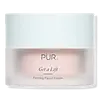What's inside
What's inside
 Key Ingredients
Key Ingredients

 Benefits
Benefits

 Concerns
Concerns

 Ingredients Side-by-side
Ingredients Side-by-side

Water
Skin ConditioningCyclopentasiloxane
EmollientGlycerin
HumectantButylene Glycol
HumectantCetyl Ethylhexanoate
EmollientDimethicone
EmollientCaprylyl Methicone
Skin ConditioningPEG-10 Dimethicone
Skin ConditioningStearyl Dimethicone
EmollientDipropylene Glycol
HumectantMedicago Sativa Extract
TonicHydrolyzed Wheat Protein
Skin ConditioningHydrolyzed Manihot Esculenta Tuber Extract
Skin ConditioningCitrus Aurantium Amara Peel Oil
Skin ConditioningLavandula Angustifolia Oil
MaskingDisteardimonium Hectorite
StabilisingPolymethyl Methacrylate
Cetyl PEG/PPG-10/1 Dimethicone
EmulsifyingMagnesium Sulfate
Sclerotium Gum
Emulsion StabilisingBis-Vinyl Dimethicone/Dimethicone Copolymer
Emulsion StabilisingCitric Acid
BufferingCI 77891
Cosmetic ColorantTin Oxide
AbrasiveSodium Citrate
BufferingSynthetic Fluorphlogopite
Phenoxyethanol
PreservativeCaprylyl Glycol
EmollientDisodium EDTA
Water, Cyclopentasiloxane, Glycerin, Butylene Glycol, Cetyl Ethylhexanoate, Dimethicone, Caprylyl Methicone, PEG-10 Dimethicone, Stearyl Dimethicone, Dipropylene Glycol, Medicago Sativa Extract, Hydrolyzed Wheat Protein, Hydrolyzed Manihot Esculenta Tuber Extract, Citrus Aurantium Amara Peel Oil, Lavandula Angustifolia Oil, Disteardimonium Hectorite, Polymethyl Methacrylate, Cetyl PEG/PPG-10/1 Dimethicone, Magnesium Sulfate, Sclerotium Gum, Bis-Vinyl Dimethicone/Dimethicone Copolymer, Citric Acid, CI 77891, Tin Oxide, Sodium Citrate, Synthetic Fluorphlogopite, Phenoxyethanol, Caprylyl Glycol, Disodium EDTA
Water
Skin ConditioningAloe Barbadensis Leaf Juice
Skin ConditioningGlycerin
HumectantPropylene Glycol
HumectantSodium Hyaluronate
HumectantCentella Asiatica Oil
AntimicrobialHydrolyzed Collagen
EmollientPanthenol
Skin ConditioningAzelaic Acid
BufferingTranexamic Acid
AstringentNiacinamide
SmoothingSqualane
EmollientMilk Protein
Skin ConditioningLaminaria Digitata Extract
Skin ProtectingLecithin
EmollientAllantoin
Skin ConditioningDipotassium Glycyrrhizate
HumectantAlpha-Arbutin
AntioxidantArgania Spinosa Kernel Oil
EmollientBetaine
HumectantPropanediol
SolventSodium PCA
HumectantCeramide AP
Skin ConditioningPEG-60 Hydrogenated Castor Oil
EmulsifyingCarbomer
Emulsion StabilisingTriethanolamine
BufferingDisodium EDTA
Menthol
MaskingEthylhexylglycerin
Skin ConditioningParfum
MaskingWater, Aloe Barbadensis Leaf Juice, Glycerin, Propylene Glycol, Sodium Hyaluronate, Centella Asiatica Oil, Hydrolyzed Collagen, Panthenol, Azelaic Acid, Tranexamic Acid, Niacinamide, Squalane, Milk Protein, Laminaria Digitata Extract, Lecithin, Allantoin, Dipotassium Glycyrrhizate, Alpha-Arbutin, Argania Spinosa Kernel Oil, Betaine, Propanediol, Sodium PCA, Ceramide AP, PEG-60 Hydrogenated Castor Oil, Carbomer, Triethanolamine, Disodium EDTA, Menthol, Ethylhexylglycerin, Parfum
 Reviews
Reviews

Ingredients Explained
These ingredients are found in both products.
Ingredients higher up in an ingredient list are typically present in a larger amount.
Disodium EDTA plays a role in making products more stable by aiding other preservatives.
It is a chelating agent, meaning it neutralizes metal ions that may be found in a product.
Disodium EDTA is a salt of edetic acid and is found to be safe in cosmetic ingredients.
Learn more about Disodium EDTAGlycerin is already naturally found in your skin. It helps moisturize and protect your skin.
A study from 2016 found glycerin to be more effective as a humectant than AHAs and hyaluronic acid.
As a humectant, it helps the skin stay hydrated by pulling moisture to your skin. The low molecular weight of glycerin allows it to pull moisture into the deeper layers of your skin.
Hydrated skin improves your skin barrier; Your skin barrier helps protect against irritants and bacteria.
Glycerin has also been found to have antimicrobial and antiviral properties. Due to these properties, glycerin is often used in wound and burn treatments.
In cosmetics, glycerin is usually derived from plants such as soybean or palm. However, it can also be sourced from animals, such as tallow or animal fat.
This ingredient is organic, colorless, odorless, and non-toxic.
Glycerin is the name for this ingredient in American English. British English uses Glycerol/Glycerine.
Learn more about GlycerinWater. It's the most common cosmetic ingredient of all. You'll usually see it at the top of ingredient lists, meaning that it makes up the largest part of the product.
So why is it so popular? Water most often acts as a solvent - this means that it helps dissolve other ingredients into the formulation.
You'll also recognize water as that liquid we all need to stay alive. If you see this, drink a glass of water. Stay hydrated!
Learn more about Water